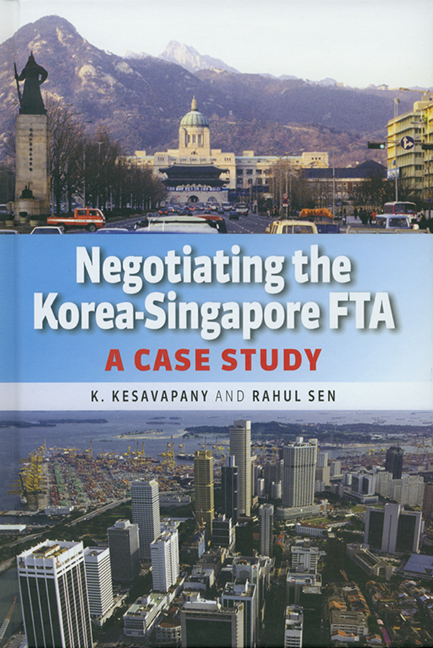Book contents
- Frontmatter
- Contents
- Foreword
- Preface
- 1 Background to the Korea-Singapore FTA
- 2 Singapore and Korea: Expanding Economic Linkages
- 3 Korea-Singapore Economic Relations After FTA: Towards a Mature Partnership
- 4 Salient Features of the KSFTA and Expected Benefits for Singapore
- 5 Singapore-Korea Business Linkages Post-KSFTA and Implementation
- 6 Concluding Remarks
- Notes
- References
- Appendix The Free Trade Agreement Between Korea and Singapore
1 - Background to the Korea-Singapore FTA
Published online by Cambridge University Press: 21 October 2015
- Frontmatter
- Contents
- Foreword
- Preface
- 1 Background to the Korea-Singapore FTA
- 2 Singapore and Korea: Expanding Economic Linkages
- 3 Korea-Singapore Economic Relations After FTA: Towards a Mature Partnership
- 4 Salient Features of the KSFTA and Expected Benefits for Singapore
- 5 Singapore-Korea Business Linkages Post-KSFTA and Implementation
- 6 Concluding Remarks
- Notes
- References
- Appendix The Free Trade Agreement Between Korea and Singapore
Summary
INTRODUCTION
Singapore has always been a leading advocate of global trade liberalization and is often placed in the league of “super-trading” nations. Its total trade volume is currently three times its GDP. Its growth strategy over the past decades has maintained a policy of outward orientation and reduced barriers to international trade and investment. Fully committed to the WTO, Singapore believes that it is the only mechanism that can ensure a fair, inclusive and predictable environment for all economies to engage in and benefit from trade. However, limited progress in the WTO on the multilateral trade and investment liberalization process in recent years has pursuaded it to simultaneously pursue the second and third tracks to trade liberalization through the regional and bilateral routes, in order to sustain its global competitiveness in the international market.
The move towards bilateral trade liberalization through the pursual of Free Trade Agreements (FTAs) was particularly evident in the aftermath of the East Asian crisis of 1997–98, and its resultant adverse impact on trade and liberalization efforts within ASEAN and the APEC. With the slowing down in the pace of and willingness of Singapore's ASEAN neighbours to undertake trade and investment liberalization, Singapore was persuaded to explore the third route of trade liberalization through bilateralism to advance freer trade in Southeast Asia. This strategy has been aimed at complementing its strong advocacy of multilateral liberalization. Singapore's policymakers are convinced that suitably designed regional and bilateral Free Trade Agreements can complement the WTO and help stimulate further global trade libralization and play a catalytic role in moving the WTO forward.
- Type
- Chapter
- Information
- Negotiating the Korea-Singapore FTAA Case Study, pp. 1 - 4Publisher: ISEAS–Yusof Ishak InstitutePrint publication year: 2007

